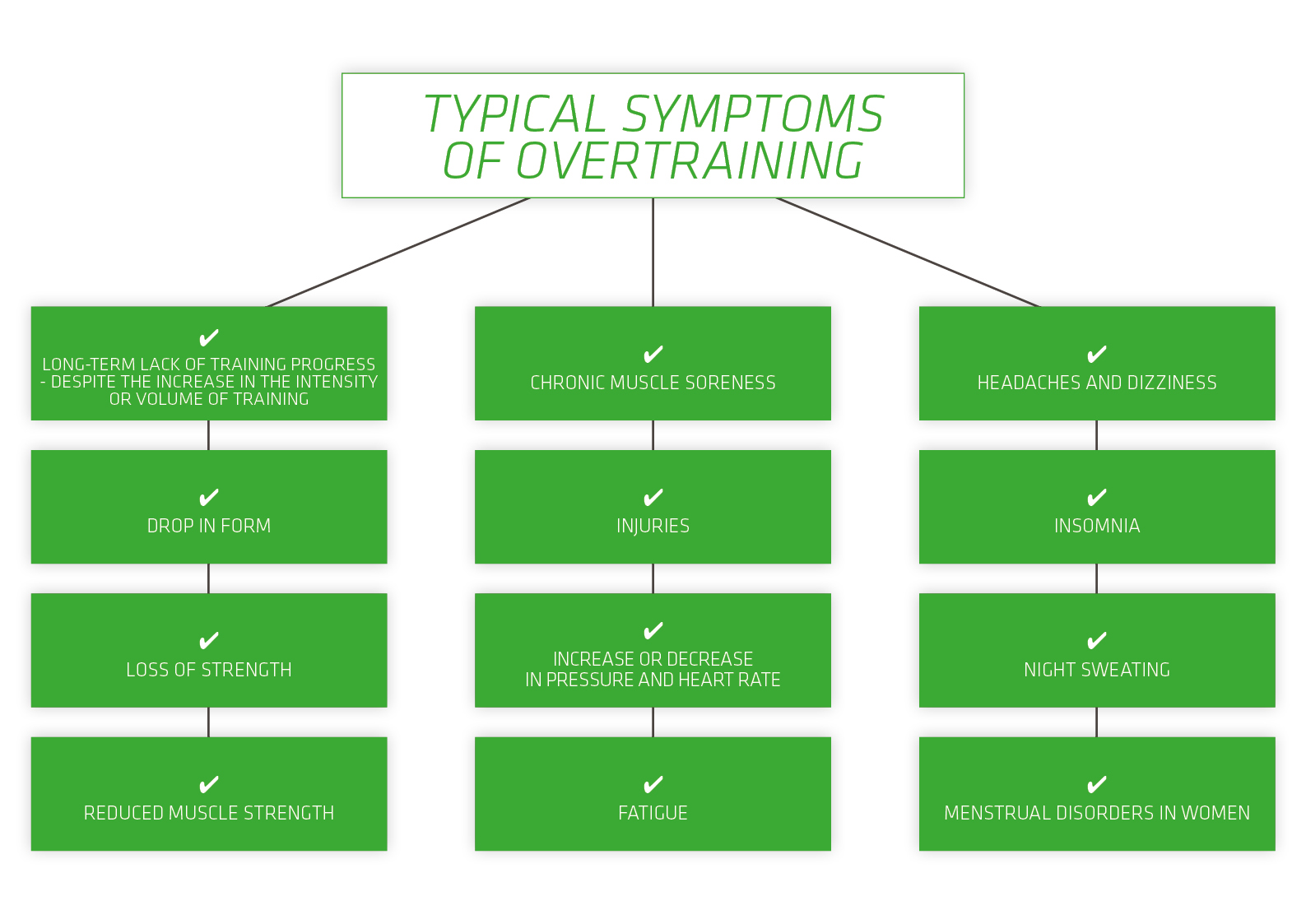You spend most of your time in the gym, you use long aerobic units, you have hundreds of hours of training behind you, and yet the effects are not exactly what you expected. In order to achieve the desired figure, you additionally use a reducing diet for a long time. Discouraged by the lack of satisfactory changes, you are constantly reducing your caloric supply, and you still do not see the dream form in the mirror. If any of these problems concern you, you should definitely read this article!
Overtraining - not just the athletes’ issue

Physical effort is a big challenge for the body, so it is important to care for proper regeneration, so as not to lead to overtraining. Due to the increase in energy demand and physiological requirements for our nervous system, cardiovascular system and muscles - physically active people should adequately react to disturbing symptoms coming from the body.
Specific training variables in conjunction with a given supply of energy derived from food, evoke various hormonal responses and adaptation consequences. Our body must be provided with adequate regeneration conditions in order to correctly respond to our treatments, aimed at achieving the desired form.
Have you noticed stagnation in the development of your figure for some time? There are several reasons that could have led you to this state. One of the reasons may be overtraining, but there is also the possibility that you suffer from adrenal insufficiency or a syndrome called "metabolic damage". In addition, there are also chronic infections, inflammations, intestinal dysbiosis and chronic diseases. At a time when all these factors are cumulative, you can observe a decrease in the quality of your life.
What exactly is an overtaining?
Overtraining occurs as a result of imbalance between training and regeneration. We distinguish two forms of overtraining, which are related to the dominance of a system in the nervous system. Overtraining on the parasympathetic system - usually develops after a few weeks of daily cardio training, taking place for 2-4 hours a day with the application of a caloric supply limit. The second type is the overtraining of the sympathetic system, occurring after heavy strength training or sprint sports, as well as for people who incorrectly plan their training, increasing the volume or intensity of training to the current level of advancement inadequately. Initially, most people ignore any symptoms - characterized by weakness of strength, agility, dexterity, increased regeneration time, which in the long run will have a negative impact on health and sports performance.
Are you over trained?

Probably you've often thought that the profits in the development of the figure do not come evenly with the work you put in. Muscle mass does not increase as it should, and fat tissue does not fall as fast as we would expect. When your sports performance is getting worse, it's worth thinking if all this is not accidentally caused by overtraining.

Imbalance between the training stimulus and the stressor stress tolerance resulting in overtraining can be observed by performing appropriate diagnostic tests. Biochemical indicators showing overtraining:
• creatine kinase - a high value indicates the damage of muscle cells,
• urea - there is a higher concentration when overtraining,
• catecholamine in the urine - a low value indicates overtraining of the parasympathetic system.
In addition to the study of substrates (eg lactate, ammonia and urea) and enzymes (eg creatine kinase) as markers of overtraining, it is worth noting whether there are more frequent diseases and infections. The indicator of overtraining is also the occurrence of delayed onset muscle soreness (so-called DOMS), commonly referred to as "muscle sores" over a longer period.
Consequences of overtraining
Overtraining also significantly affects stress hormones - cortisol and adrenaline. Hormonal imbalance may correlate with a negative mood, leading to the emergence of irritability and impossibility of concentration. Long-term, low energy supply can lead to nutrient deficiencies. In addition, there may be problems such as iron deficiency anemia, impaired thyroid function or more frequent infections. Other consequences include complications involving the cardiovascular, gastrointestinal or hormonal, nervous or reproductive systems.
Physical effort is the stress for organism that can contribute to the menstrual period in women by disrupting the hypothalamic-pituitary-adrenal axis. In the over trained person, there is a reduction in muscle glycogen stores, which leads to a decrease in exercise capacity. Inhibition of protein synthesis, intensification of their breakdown will result in impaired regeneration and in the long-term time loss of muscle mass.
Take care of 3 basic foundations to avoid overtraining
Adapting gradually to the effort, we should simultaneously care for areas such as nutrition and regeneration, which will support the process of shaping the dream sport form:
• training
it should be properly matched to our level of proficiency and possibilities. Assumed training goals must be real and spread over time;
• diet
food is a fuel. A properly selected number of calories, individually distributed macronutrients in relation to the training plan and health status are the key to achieving the assumed effects;
• regeneration
man is not a machine, and more not always means better. Lack of sleep, too much stress will cause disturbances in regeneration processes, which will certainly affect negatively on the sports form.

Conclusions
The effects of overtraining can lead to serious health consequences. Focus on ensuring proper regeneration, considering the hygiene of sleep, proper caloric supply and individually selected training to your abilities. Adequate training periodization and proper caloric supply adjusted to the type of effort are the key to achieving the set training or body goals, without adversely affecting your health.




